This blog is concerned with what is scientific. We are doing everything we can in order to bring you all that is new in the world of technology Support Us by your comments; encouragements and why not donate 0,5$ or any other amount you can. Thank you!
AMAZON
Wednesday, September 10, 2014
Monday, September 8, 2014
Brain-computer Interfaces

Recent research has focused on the possibility of using brain-computer interfaces to connect different brains together directly. Researchers at Duke University last year reported successfully connecting the brains of two mice over the Internet (into what was termed a “brain net”) where mice in different countries were able to cooperate to perform simple tasks to generate a reward. Also in 2013, scientists at Harvard University reported that they were able to establish a functional link between the brains of a rat and a human with a non-invasive, computer-to-brain interface.
Other research projects have focused on manipulating or directly implanting memories from a computer into the brain. In mid-2013, MIT researchers reported having successfully implanted a false memory into the brain of a mouse. In humans, the ability to directly manipulate memories might have an application in the treatment of post-traumatic stress disorder, while in the longer term, information may be uploaded into human brains in the manner of a computer file. Of course, numerous ethical issues are also clearly raised by this rapidly advancing field.
Quantified Self (Predictive Analytics)

Smartphones contain a rich record of people’s activities, including who they know (contact lists, social networking apps), who they talk to (call logs, text logs, e-mails), where they go (GPS, Wi-Fi, and geotagged photos) and what they do (apps we use, accelerometer data). Using this data, and specialized machine-learning algorithms, detailed and predictive models about people and their behaviours can be built to help with urban planning, personalized medicine, sustainability and medical diagnosis.
For example, a team at Carnegie Mellon University has been looking at how to use smartphone data to predict the onset of depression by modelling changes in sleep behaviours and social relationships over time. In another example, the Livehoods project, large quantities of geotagged data created by people’s smartphones (using software such as Instagram and Foursquare) and crawled from the Web have allowed researchers to understand the patterns of movement through urban spaces.
In recent years, sensors have become cheap and increasingly ubiquitous as more manufacturers include them in their products to understand consumer behaviour and avoid the need for expensive market research. For example, cars can record every aspect of a person’s driving habits, and this information can be shown in smartphone apps or used as big data in urban planning or traffic management. As the trend continues towards extensive data gathering to track every aspect of people’s lives, the challenge becomes how to use this information optimally, and how to reconcile it with privacy and other social concerns.
RNA-based Therapeutics

Over the past year, there has been a resurgence of interest in this new field of biotech healthcare, with two RNA-based treatments approved as human therapeutics as of 2014. RNA-based drugs for a range of conditions including genetic disorders, cancer and infectious disease are being developed based on the mechanism of RNA interference, which is used to silence the expression of defective or overexpressed genes.
Extending the repertoire of RNA-based therapeutics, an even newer platform based on messenger RNA (mRNA) molecules is now emerging. Specific mRNA sequences injected intramuscularly or intravenously can act as therapeutic agents through the patient’s own cells, translating them into the corresponding proteins that deliver the therapeutic effect. Unlike treatments aimed at changing DNA directly, RNA-based therapeutics do not cause permanent changes to the cell’s genome and so can be increased or discontinued as necessary.
Advances in basic RNA science, synthesis technology and in vivo delivery are combining to enable a new generation of RNA-based drugs that can attenuate the abundance of natural proteins, or allow for the in vivo production of optimized, therapeutic proteins. Working in collaboration with large pharmaceutical companies and academia, several private companies that aim to offer RNA-based treatments have been launched. We expect this field of healthcare to increasingly challenge conventional pharmaceuticals in forging new treatments for difficult diseases in the next few years.
Human Microbiome Therapeutics

Through advanced DNA sequencing, bioinformatics and culturing technologies, the diverse microbe species that cohabitate with the human body are being identified and characterized, with differences in their abundance correlated with disease and health.
It is increasingly understood that this plethora of microbes plays an important role in our survival: bacteria in the gut, for example, allow humans to digest foods and absorb important nutrients that their bodies would otherwise not be able to access. On the other hand, pathogens that are ubiquitous in humans can sometimes turn virulent and cause sickness or even death.
Attention is being focused on the gut microbiome and its role in diseases ranging from infections to obesity, diabetes and inflammatory bowel disease. It is increasingly understood that antibiotic treatments that destroy gut flora can result in complications such as Clostridium difficile infections, which can in rare cases lead to life-threatening complications. On the other hand, a new generation of therapeutics comprising a subset of microbes found in healthy gut are under clinical development with a view to improving medical treatments. Advances in human microbiome technologies clearly represent an unprecedented way to develop new treatments for serious diseases and to improve general healthcare outcomes in our species.
Screenless Display

Screenless display may also be achieved by projecting images directly onto a person’s retina, not only avoiding the need for weighty hardware, but also promising to safeguard privacy by allowing people to interact with computers without others sharing the same view. By January 2014, one start-up company had already raised a substantial sum via Kickstarter with the aim of commercializing a personal gaming and cinema device using retinal display. In the longer term, technology may allow synaptic interfaces that bypass the eye altogether, transmitting “visual” information directly to the brain.
This field saw rapid progress in 2013 and appears set for imminent breakthroughs of scalable deployment of screenless display. Various companies have made significant breakthroughs in the field, including virtual reality headsets, bionic contact lenses, the development of mobile phones for the elderly and partially blind people, and hologram-like videos without the need for moving parts or glasses.
Nanowire Lithium-ion Batteries

Batteries are typically composed of two electrodes, a positive terminal known as a cathode, and a negative terminal known as an anode, with an electrolyte in between. This electrolyte allows ions to move between the electrodes to produce current. In lithium-ion batteries, the anode is composed of graphite, which is relatively cheap and durable. However, researchers have begun to experiment with silicon anodes, which would offer much greater power capacity.
One engineering challenge is that silicon anodes tend to suffer structural failure from swelling and shrinking during charge-discharge cycle. Over the last year, researchers have developed possible solutions that involve the creation of silicon nanowires or nanoparticles, which seem to solve the problems associated with silicon’s volume expansion when it reacts with lithium. The larger surface area associated with nanoparticles and nanowires further increases the battery’s power density, allowing for fast charging and current delivery.
Able to fully charge more quickly, and produce 30%-40% more electricity than today’s lithium-ion batteries, this next generation of batteries could help transform the electric car market and allow the storage of solar electricity at the household scale. Initially, silicon-anode batteries are expected to begin to ship in smartphones within the next two years.
Grid-scale Electricity Storage

Clean energy sources, in particular wind and solar, can be highly intermittent; instead of producing electricity when consumers and grid managers want it, they generate uncontrollable quantities only when favourable weather conditions allow. A scaled-up nuclear sector might also present challenges due to its preferred operation as always-on baseload. Hence, the development of grid-scale electricity storage options has long been a “holy grail” for clean energy systems. To date, only pumped storage hydropower can claim a significant role, but it is expensive, environmentally challenging and totally dependent on favourable geography.
There are signs that a range of new technologies is getting closer to cracking this challenge. Some, such as flow batteries may, in the future, be able to store liquid chemical energy in large quantities analogous to the storage of coal and gas. Various solid battery options are also competing to store electricity in sufficiently energy-dense and cheaply available materials. Newly invented graphene supercapacitors offer the possibility of extremely rapid charging and discharging over many tens of thousands of cycles. Other options use kinetic potential energy such as large flywheels or the underground storage of compressed air.
A more novel option being explored at medium scale in Germany is CO2 methanation via hydrogen electrolysis, where surplus electricity is used to split water into hydrogen and oxygen, with the hydrogen later being reacted with waste carbon dioxide to form methane for later combustion – if necessary, to generate electricity. While the round-trip efficiency of this and other options may be relatively low, clearly storage potential will have high economic value in the future. It is too early to pick a winner, but it appears that the pace of technological development in this field is moving more rapidly than ever, in our assessment, bringing a fundamental breakthrough more likely in the near term.
Mining Metals from Desalination Brine

Desalination has serious drawbacks, however. In addition to high energy use (a topic covered in last year’s Top 10 Emerging Technologies), the process produces a reject-concentrated brine, which can have a serious impact on marine life when returned to the sea. Perhaps the most promising approach to solving this problem is to see the brine from desalination not as waste, but as a resource to be harvested for valuable materials. These include lithium, magnesium and uranium, as well as the more common sodium, calcium and potassium elements. Lithium and magnesium are valuable for use in high-performance batteries and lightweight alloys, for example, while rare earth elements used in electric motors and wind turbines – where potential shortages are already a strategic concern – may also be recovered.
New processes using catalyst-assisted chemistry raise the possibility of extracting these metals from reject desalination brine at a cost that may eventually become competitive with land-based mining of ores or lake deposits. This economic benefit may offset the overall cost of desalination, making it more viable on a large scale, in turn reducing the human pressures on freshwater ecosystems.
Nanostructured Carbon Composites

However, efficiency is only one concern – another of equal importance is improving passenger safety. To increase the strength and toughness of new composites, the interface between carbon fibres and the surrounding polymer matrix is engineered at the nanoscale to improve anchoring – using carbon nanotubes, for example. In the event of an accident, these surfaces are designed to absorb impact without tearing, distributing the force and protecting passengers inside the vehicle.
A third challenge, which may now be closer to a solution, is that of recycling carbon fibre composites – something which has held back the widespread deployment of the technology. New techniques involve engineering cleavable “release points” into the material at the interface between the polymer and the fibre so that the bonds can be broken in a controlled fashion and the components that make up the composite can be recovered separately and reused. Taken together, these three elements could have a major impact by bringing forward the potential for manufacturing lightweight, super-safe and recyclable composite vehicles to a mass scale.
Body-adapted Wearable Electronics

From Google Glass to the Fitbit wristband,
wearable technology has generated significant attention over the past
year, with most existing devices helping people to better understand
their personal health and fitness by monitoring exercise, heart rate,
sleep patterns, and so on. The sector is shifting beyond external
wearables like wristbands or clip-on devices to “body-adapted”
electronics that further push the ever-shifting boundary between humans
and technology.
The new generation of wearables is designed to adapt to the human
body’s shape at the place of deployment. These wearables are typically
tiny, packed with a wide range of sensors and a feedback system, and
camouflaged to make their use less intrusive and more socially
acceptable. These virtually invisible devices include earbuds that
monitor heart rate, sensors worn under clothes to track posture, a
temporary tattoo that tracks health vitals and haptic shoe soles that
communicate GPS directions through vibration alerts felt by the feet.
The applications are many and varied: haptic shoes are currently
proposed for helping blind people navigate, while Google Glass has
already been worn by oncologists to assist in surgery via medical
records and other visual information accessed by voice commands.
Technology analysts consider that success factors for wearable products include device size, non-invasiveness, and the ability to measure multiple parameters and provide real-time feedback that improves user behaviour. However, increased uptake also depends on social acceptability as regards privacy. For example, concerns have been raised about wearable devices that use cameras for facial recognition and memory assistance. Assuming these challenges can be managed, analysts project hundreds of millions of devices in use by 2016.
Technology analysts consider that success factors for wearable products include device size, non-invasiveness, and the ability to measure multiple parameters and provide real-time feedback that improves user behaviour. However, increased uptake also depends on social acceptability as regards privacy. For example, concerns have been raised about wearable devices that use cameras for facial recognition and memory assistance. Assuming these challenges can be managed, analysts project hundreds of millions of devices in use by 2016.
Sunday, September 7, 2014
Integration of robotic systems for high throughput lab automation

Today, more than ever, lab technicians in R&D and QC areas facing a growing array of new challenges. Not only are product quality, health and safety (think of REACH) requirements in- creasingly stringent, but fierce competition is also forcing companies to develop and test (new) products in shorter time spans. So with the many challenges that lie ahead for product developers, Robotic integration in a HT Lab is now an indispensable tool. And thankfully I am not the only person who thinks so.
During this presentation we would like to discuss a few examples of the endless possibilities of custom lab automation and the challenges we face within Automation in some very different domains. From lubricating oils, milk, water and other materials over a wide viscosity range.
1. Application Examples
- High Throughput Sub Sampling systems for used oils where we reformat from primary vials to IR vials inclusive the integration of; capping and decapping functionality – automatic stacking of input and output racks – PQ Analyzer and Crackle tests. Subsampling can also be done for TAN, TBN, etc
- High Throughput Sub Sampling system for water analyses where water samples were stored in a large storage center, capacity of 1200 sample bottles – capping/de-capping – integration of pH measurement and turbidity check – sub sampling to ICP vials.
- High Throughput Purification and Reformatting as part of a complete crude products purification and reformatting process, including analysis, purifying, weighing, reformatting, drying, capping and a custom database.
The software offers the possibility to define detailed parameters in order to automate your process of lubricating oils, Water, Milk and similar materials over a wide viscosity range in the most efficient way. With this we aim to achieve the best possible result. In our standard Xperimate Toolbox software which controls all robotics and third party equipment you can define various options such as; Setup of calibration- and QA-standards, Setup of samples, Setup of pipetting parameters, Measuring parameters, Factor calculations. Ideally every sample has a unique barcode and is treated automatically according to a predefined work list.
1.2. LIMS and Work list
To work fully automatically, all system needs sample information files. These work lists hold the number of samples with their specific sample information and treatment.
These sample work list can be obtained in two ways:
- Automatically from the LIMS.
- Manual entry of work lists.
An enclosure around the system protects the lab technician against the robot arm. When opening the door to load or remove samples the system will automatically pause and continue when door closes.
NEW – VACUETTE® Super-T Disposable Tourniquet

The new tourniquet is SUPER CONVENIENT and SUPER SIMPLE to use!
Innovative products are often defined by their ease of use and this certainly applies to the VACUETTE® Super-T.
The product is made of virtually untearable silicone. Super-T is
comfortable for patients and the material used prevents skin
irritations. It is a single use product. Patients are protected from
potential cross-contamination.
The advantages at a glance:
- Easy to use*
- Virtually untearable*
- Single-use*
- Protects from cross-contamination*
- Helps to reduce nosocomial infections (MRSA*)
- Soft slicone material*
- Gentle to use on patients*
- Latex-free and non-DEHP*
- Practical packaging*
- Easy to remove from the box*
Saturday, September 6, 2014
Apple's new iPhone 6 will be introduced at a September 9

Apple's new iPhone 6 will be introduced at a September 9 media event at the Flint Center, the same location
where Apple debuted the original Mac 30 years ago. An overwhelming
number of iPhone 6 rumors and part leaks have given us a near-complete
look at the device ahead of its launch.
With the iPhone 5, Apple increased the screen size of the device from
3.5 inches to 4 inches, and with the iPhone 6, the phone's display is
going to grow even larger. Though Apple experimented with a range of
screen sizes, the company settled on 4.7 inches and 5.5 inches for its
two devices, which will bring the next iPhone in line with competing
Android and Windows phones that have adopted larger displays.
Over the course of the last several years, consumer preference has
shifted towards bigger screens, and Apple is now prepared to meet
consumer demand for larger devices

Along with a larger screen, both models of the iPhone 6 are expected
to adopt design elements from the iPad and the iPod touch. Alleged iPhone 6 schematics
and part leaks have suggested the iPhone 6 will be considerably thinner
than the current iPhone 5s, which is 7.6 mm. The final version of the
4.7-inch iPhone 6 is said to be 6.9 mm thick, 138 mm long, and 66 mm
wide. The 5.5-inch iPhone 6 is said to be 7.1 mm thick, 158 mm long, and
78 mm wide.
The phones will also include rounded iPad-style corners, pill-shaped
volume buttons, thick antenna bands, a rounded True Tone dual-LED flash,
an embedded Apple logo, and a power button located on the right side of
the device.
Rumors have suggested at least some models of the iPhone 6 might feature a durable sapphire display
and both the 4.7 and 5.5-inch iPhone 6 are expected to see camera
improvements. The larger 5.5-inch iPhone 6 might incorporate Optical
Image Stabilization as a differentiating feature from the 4.7-inch iPhone 6, and it is also possible that the larger iPhone 6 will be the only model with a 128GB storage capacity, which has been mentioned in rumors and seen in leaked schematics. As a result, the larger phone might have a higher price tag.
Images of a completed logic board have suggested the 4.7-inch iPhone 6 will continue to offer 16GB of storage space at the low end, along with 1GB of RAM, support for NFC, and a Qualcomm MDM9625M LTE Modem
that supports speeds of up to 150 Mbps. Specifications for the larger
5.5-inch iPhone remain unknown, but the device will likely include many
of the same components.
While Apple is expected to introduce both the 4.7 and 5.5-inch iPhone 6
models at its September event, there has been some disagreement about
the launch date of the 5.5-inch iPhone 6. Due to production issues that
may or may not be resolved, the larger 5.5-inch iPhone could launch alongside the 4.7-inch version, or at a somewhat later date
With less than a month to go until Apple's scheduled September 9 iPhone event,
alleged iPhone 6 part leaks are being shared on a daily basis. At this
point, we've seen virtually every part of the 4.7-inch iPhone 6, giving
us a clear look at what the final device may look like.
While none of the part leaks shared below can be verified as
authentic, they have come from an array of different sources and they
match up with previously leaked design schematics and mockups. The high
quality of many of the parts depicted in the images also points towards
their authenticity, as does their similarity to existing iPhone 5s
parts.
Beginning with a video that depicts a near-complete 4.7-inch iPhone 6
said to be assembled from an array of different acquired parts by
Russian luxury vendor Feld & Volk, we'll share each part of the
iPhone 6 leaked thus far, explaining how all of the pieces fit together
to form a complete device and how certain parts reveal clues about the
iPhone 6's specifications.
In addition to the above video, images of the 4.7-inch iPhone 6's
front panel and its rear shell assembled together have given us a solid
look at what the final iPhone 6 design might look like
upon release. In the photos, the front panel's slightly tapered edges
meld seamlessly into the rounded edges of the rear shell for a sleek,
continuous curve.
 With its softly rounded corners and redesigned pill-shaped volume
buttons, the iPhone 6 closely resembles the style of the iPad mini, iPad
Air, and newest iPod touch. Shell images also suggest the iPhone 6 will
adopt redesigned speaker holes, a round True Tone flash, an embedded
Apple logo, and a relocated right-side power button for easier
one-handed use.
With its softly rounded corners and redesigned pill-shaped volume
buttons, the iPhone 6 closely resembles the style of the iPad mini, iPad
Air, and newest iPod touch. Shell images also suggest the iPhone 6 will
adopt redesigned speaker holes, a round True Tone flash, an embedded
Apple logo, and a relocated right-side power button for easier
one-handed use.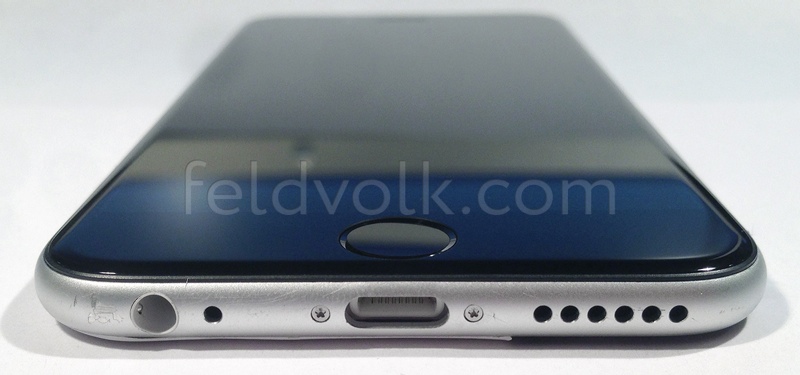
As seen in the image above, the glossy 4.7-inch iPhone 6 front panel has thinner bezels and slightly tapered, rounded edges that will fit tightly with the rear shell.
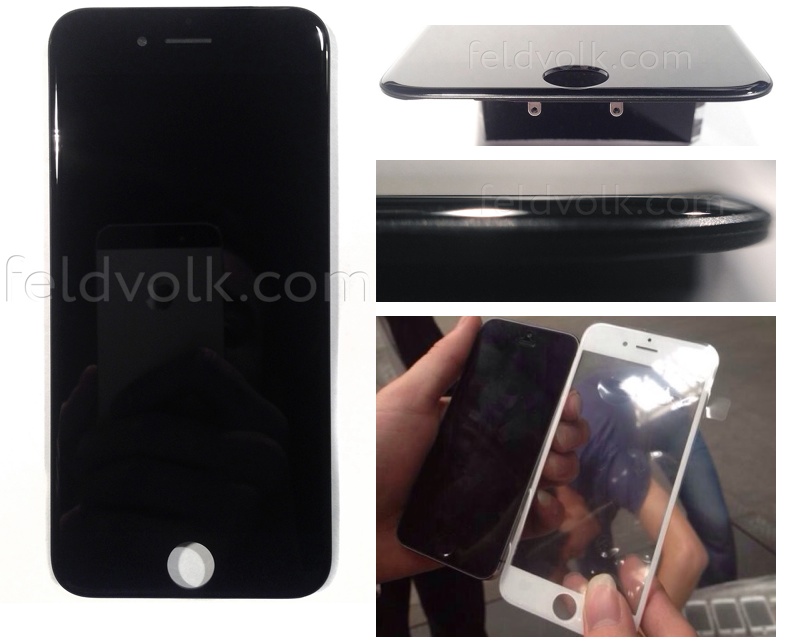
A set of durability tests that involved bending and scratching the front panel suggest that it is highly scratch resistant, but a later scratch test indicated the front panel may not be made of sapphire.
The front panel attaches directly to a display assembly, which has been seen in several different photos thus far. In the image below, for example, the front panel and display assembly
is shown, along with the layout of several internal parts including the
digitizer/LCD flex cables and earpiece, the front camera, and the
proximity/ambient light sensors
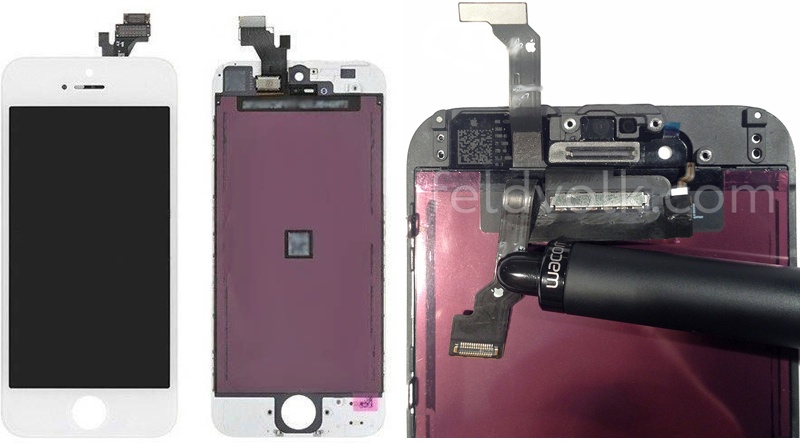
The display assembly includes the backlight panel, which was actually one of the first internal parts to leak. While the panel cannot be confirmed as legitimate, it does appear similar to the backlight panel of the iPhone 5s and it also appears to correspond to a 4.7-inch device. Rumors have suggested Apple will take advantage of advancements in LED backlighting technology to shrink the thickness of the iPhone 6.
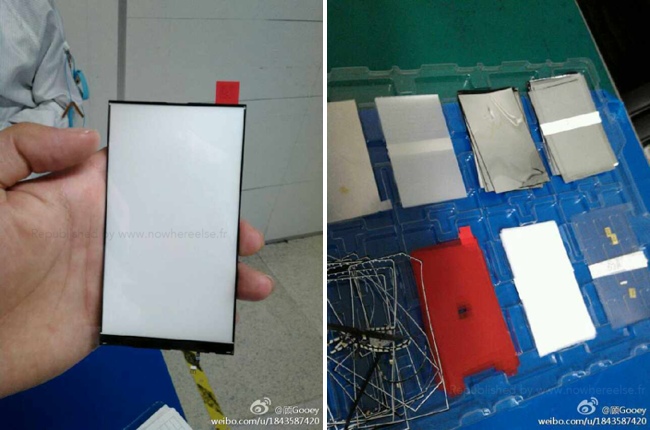
Both the front panel and the display assembly are designed to connect seamlessly to the rear shell of the device, which is what houses many other internal parts including the logic board, battery, Touch ID module, Lightning port assembly, home button, and various flex cables that connect everything together.
Made of thin metal with cutouts for the Apple logo and rear camera, detailed images of the rear shell show the same thick antenna breaks that have been previously seen in iPhone 6 mockups and schematics.
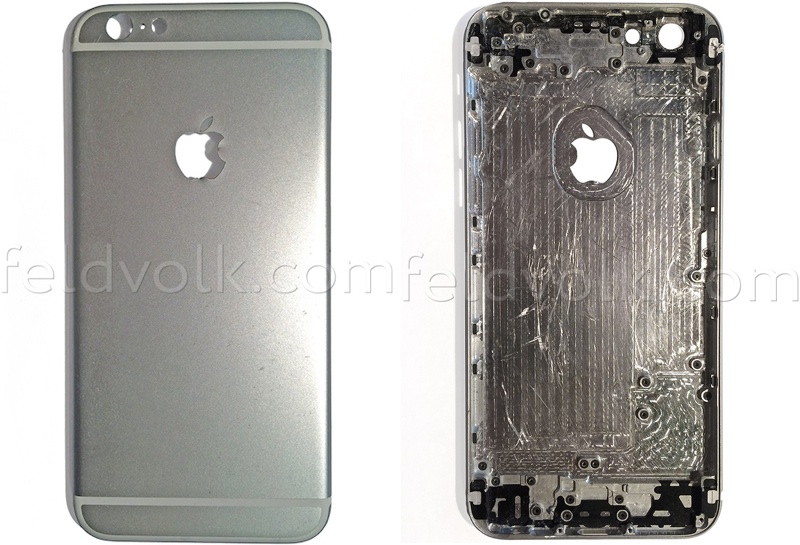
In comparison to the iPhone 5s, measurements of the iPhone 6 casing
and leaked schematics suggest the device is significantly thinner, in the range 7mm.
The iPhone 5s shell measures in at 7.6mm, with the iPhone 6 doing away
with flat edges in favor of a design that more closely resembles the
iPod touch.

Recent images said to depict the finished rear shell of the 4.7-inch iPhone 6 have shown the thick antenna bands of the device colored to fit with the rest of the device, making them less obtrusively than the bands seen in previous images.

Along with iPod touch-style rounded corners, the iPhone 6 is expected
to take additional design cues from the iPod and the iPad. Part leaks
have suggested the iPhone 6 volume/mute buttons and will be elongated
and pill-shaped much like those on the iPad, and the iPhone 6 power
button is expected to shift from the top of the device to the right hand side in order to make one-handed usage easier
.
..Samsung Galaxy S5 black Deals

The Samsung Galaxy S5 is the very latest Android smartphone from Samsung with a stunning 5.1-inch touchscreen display and powerful 2.5GHz quad-core processor. Android 4.4 is on board so you get the very latest updates from Google and the Samsung UI includes many fantastic features such as S Health which uses the built-in heart monitor and Smart Stay which will keep the screen illuminated for as long as you are looking at it. The camera on this smartphone is impressive with a 16-megapixel resolution and the ability to capture 4K HD video. The camera includes many features and effects to create superb photos including Select Focus so you can blur the background or other part of the photo to make your subject really stand out. The phone supports 4G, Wi-Fi, GPS, DLNA and NFC and includes an SD card slot for a card up to 128GB so there is lots of space for apps, images or games. Other features include a 2.1-megapixel front facing camera, fingerprint scanner and the ability to activate a Kid's Mode so your children can use the phone but with restricted access to certain functions.
Specifications
Weight: 145g
Standby battery time: 2 weeks, 2 days, 6 hours and 1 minute




Subscribe to:
Posts (Atom)